
HMS Devonshire, pennant number 39, was a County-class heavy cruiser of the London sub-class built for the Royal Navy in the late 1920s. The ship spent most of her pre-World War II career assigned to the Mediterranean Fleet aside from a brief tour with the China Station. She spent the first two months of the Second World War in the Mediterranean until she was transferred to the Home Fleet and became flagship of a cruiser squadron. Devonshire took part in the Norwegian Campaign in mid 1940 and evacuated much of the Norwegian Government in June. Several months later, she participated in the Battle of Dakar, a failed attempt to seize the Vichy French colony of Senegal in September. The ship remained in the South Atlantic afterwards and supported Free French efforts to take control of French Equatorial Africa in addition to searching for German commerce raiders.
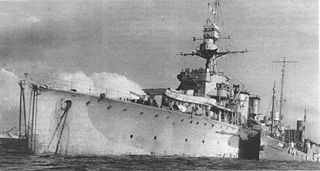
HMS Dragon, also known in Polish service as ORP Dragon, was a D- or Danae-class cruiser built for the Royal Navy. She was launched in Glasgow, in December 1917, and scuttled in July 1944 off the Normandy beaches as part of the Arromanches Breakwater.

HMS Kenya was a Fiji-class cruiser of the Royal Navy. The ship was named after Kenya, a British possession at the time of the ship's construction.

HMS Ajax was a Leander-class light cruiser which served with the Royal Navy during World War II. She became famous for her part in the Battle of the River Plate, the Battle of Crete, the Battle of Malta and as a supply escort in the siege of Tobruk. This ship was the eighth in the Royal Navy to bear the name. In February 1942, she was adopted by the civil community of Halifax, West Yorkshire.
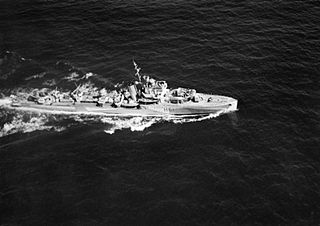
HMS Express was an E-class minelaying destroyer built for the Royal Navy in the early 1930s. Although assigned to the Home Fleet upon completion, the ship was attached to the Mediterranean Fleet in 1935–36 during the Abyssinia Crisis. During the Spanish Civil War of 1936–1939, she spent considerable time in Spanish waters, enforcing the arms blockade imposed by Britain and France on both sides of the conflict.

HMAS Sydney, named for the Australian city of Sydney, was one of three modified Leander-class light cruisers operated by the Royal Australian Navy (RAN). Ordered for the Royal Navy as HMS Phaeton, the cruiser was purchased by the Australian government and renamed prior to her 1934 launch.

HMAS Hobart was a modified Leander-class light cruiser which served in the Royal Australian Navy (RAN) during World War II. Originally constructed for the Royal Navy as HMS Apollo, the ship entered service in 1936, and was sold to Australia two years later. During the war, Hobart was involved in the evacuation of British Somaliland in 1940, fought at the Battle of the Coral Sea and supported the amphibious landings at Guadalcanal and Tulagi in 1942. She was torpedoed by a Japanese submarine in 1943, then returned to service in 1945 and supported the landings at Tarakan, Wewak, Brunei, and Balikpapan. Hobart was placed in reserve in 1947, but plans to modernise her and return her to service as an aircraft carrier escort, training ship, or guided missile ship were not followed through. The cruiser was sold for scrapping in 1962.

HMAS Perth was one of three modified Leander-class light cruisers used by the Royal Australian Navy (RAN) during the early part of World War II. She was built for the Royal Navy (RN) in the mid-1930s and was commissioned as HMS Amphion in 1936. The ship spent the next several years as flagship of the Commander-in-Chief, Africa before she was transferred to the RAN in 1939 and renamed as HMAS Perth.

HMS Cornwall, pennant number 56, was a County-class heavy cruiser of the Kent sub-class built for the Royal Navy in the mid-1920s. The ship spent most of her pre-World War II career assigned to the China Station. Shortly after the war began in August 1939, she was assigned to search for German commerce raiders in the Indian Ocean. Cornwall was transferred to the South Atlantic in late 1939 where she escorted convoys before returning to the Indian Ocean in 1941. She then sank the German auxiliary cruiser Pinguin in May. After the start of the Pacific War in December 1941, she began escorting convoys until she was transferred to the Eastern Fleet in March 1942. The ship was sunk on 5 April by dive bombers from three Japanese aircraft carriers during the Indian Ocean Raid.
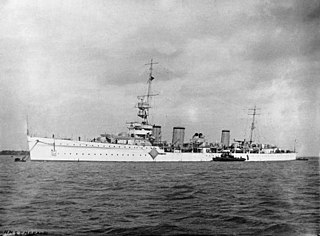
HMS Emerald was an Emerald-class light cruiser of the Royal Navy. She was built by Armstrong at Newcastle-on-Tyne, with the keel being laid down on 23 September 1918. She was launched on 19 May 1920 and commissioned 14 January 1926.
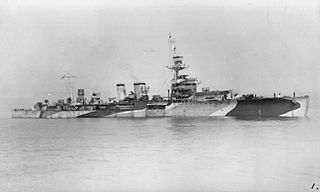
HMS Danae was the lead ship of the Danae-class cruisers, serving with the Royal Navy between the world wars and with the Polish Navy during the latter part of World War II as ORP Conrad.

HMS Diomede was a Danae-class cruiser of the Royal Navy. Constructed at Vickers Armstrong, Barrow, she was constructed too late to take part in World War I and was completed at the Royal Dockyard, Portsmouth. Between the wars, she served on the China Station, Pacific waters, East Indies Waters and from 1936 onwards, in reserve. In World War II she performed four years of arduous war duty, during which time she captured the crew of the German blockade runner Idarwald after she had chased that ship and when the crew scuttled Idarwald. Between 22 July 1942 and 24 September 1943 she was converted to a training ship at Rosyth Dockyard. In 1945 she was placed in reserve and scrapped a year later.

HMS Dunedin was a Danae-class light cruiser of the Royal Navy, pennant number D93. She was launched from the yards of Armstrong Whitworth, Newcastle-on-Tyne on 19 November 1918 and commissioned on 13 September 1919. She has been the only ship of the Royal Navy to bear the name Dunedin.
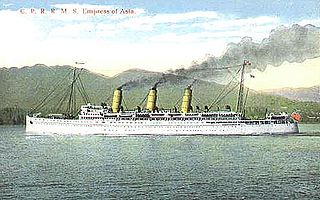
RMS Empress of Asia was an ocean liner built in 1912–1913 by Fairfield Shipbuilding and Engineering at Govan on the Clyde in Scotland for Canadian Pacific Steamships.
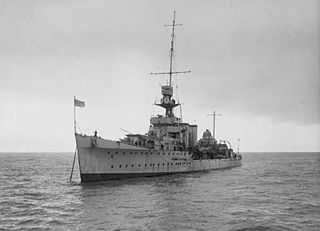
HMS Calcutta was a C-class light cruiser of the Royal Navy, named after the Indian city of Calcutta. She was part of the Carlisle group of the C class of cruisers. She was laid down by Vickers Limited at Barrow-in-Furness in 1917 and launched on 9 July 1918. Calcutta was commissioned too late to see action in the First World War and was converted to an anti-aircraft cruiser in 1939. Calcutta served during the Norwegian Campaign and the evacuation from Dunkirk in 1940. She was used to escort allied convoys across the Mediterranean and was sunk on 1 June 1941 by Luftwaffe aircraft off Alexandria, Egypt.
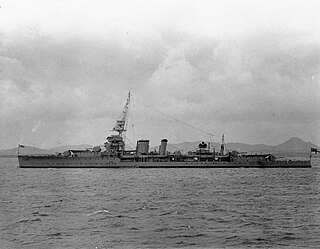
HMS Ceres was a C-class light cruiser of the Royal Navy. She was the name ship of the Ceres group of the C-class of cruisers.

HMS Nigeria was a Fiji-class light cruiser of the Royal Navy completed early in World War II and served during that conflict. She was named after the British colony of Nigeria.
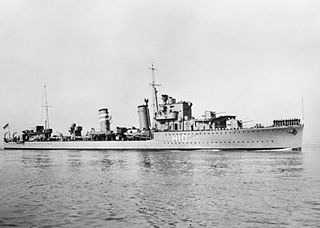
HMS Encounter was an E-class destroyer built for the Royal Navy in the early 1930s. Although assigned to the Home Fleet upon completion, the ship was attached to the Mediterranean Fleet in 1935–36 during the Abyssinia Crisis. During the Spanish Civil War of 1936–39, she spent considerable time in Spanish waters, enforcing the arms blockade imposed by Britain and France on both sides of the conflict. Encounter was assigned to convoy escort and anti-submarine patrol duties in the Western Approaches, when World War II began in September 1939. She participated in the Norwegian Campaign before joining Force H in mid-1940 and was present during the Battles of Dakar and Cape Spartivento later that year. The ship was transferred to the Mediterranean Fleet in 1941 where she escorted convoys to Malta.

HMS Defender was a D-class destroyer built for the Royal Navy in the early 1930s. The ship was initially assigned to the Mediterranean Fleet before she was transferred to the China Station in early 1935. She was temporarily deployed in the Red Sea during late 1935 during the Abyssinia Crisis, before returning to her assigned station where she remained until mid-1939. Defender was transferred back to the Mediterranean Fleet just before World War II began in September 1939. She briefly was assigned to West Africa for convoy escort duties in 1940 before returning to the Mediterranean. The ship took part in the Battles of Calabria, Cape Spartivento, and Cape Matapan over the next year without damage. Defender assisted in the evacuations from Greece and Crete in April–May 1941, before she began running supply missions to Tobruk, Libya in June. The ship was badly damaged by a German bomber on one of those missions and had to be scuttled by her consort on 11 July 1941.

HMS Falmouth was a Shoreham-class sloop of the British Royal Navy. Falmouth was built at Devonport Dockyard in 1931–1932. The ship was used as a despatch vessel on the China Station in the 1930s, but the Second World War resulted in her being rearmed, and used for escort duties. From 1952, Falmouth was used as a stationary drillship until she was scrapped in 1968.






















